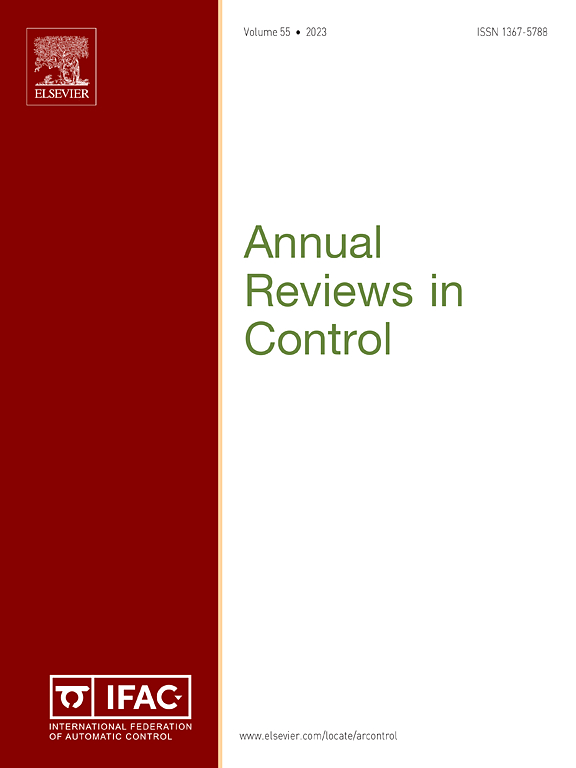A harmonious synergy between robotic performance and well-being in human-robot collaboration: A vision and key recommendations
IF 10.7
2区 计算机科学
Q1 AUTOMATION & CONTROL SYSTEMS
引用次数: 0
Abstract
The transition from Industry 4.0 to Industry 5.0 marks a significant shift towards human-centric manufacturing processes, emphasizing the integration of collaborative robots with advanced sensory and cognitive abilities. Unlike previous industrial revolutions, Industry 5.0 prioritizes the integration of human workers alongside advanced technologies, emphasizing collaboration, and acknowledging the unique strengths of both humans and machines, with a focus on human well-being. However, this transition presents significant challenges to adopting cobots in industries due to safety concerns compromising efficiency. While robotics and automation traditionally focus on maximizing performance and minimizing human intervention, the latter no longer applies to human-robot collaboration. There is a need for developing approaches and technologies that can seamlessly combine high-level robotic performance with safety, as well as pursue operator well-being. This paper presents a vision and specific recommendations for a harmonious synergy between robot performance and operator well-being in human-robot collaboration.
Our vision includes the need to develop cobots that are contextually intelligent, capable of meaningful conversation, and adaptable to changing conditions. The paper identifies current challenges, such as safety concerns impacting performance, a narrow safety focus and overlooked system-wide impacts, limited guidance on well-being, and insufficient interdisciplinary approaches. To overcome the identified challenges, key recommendations essential for achieving the vision are outlined, and pathways to overcome remaining obstacles are presented. These recommendations include designing context-aware, cognitively embodied, and socially proficient cobots; balancing autonomy and control in task allocation; and adopting a socio-technical systems perspective. Although numerous technical obstacles remain, the rapid advances in Artificial Intelligence (AI), particularly in generative AI, provide an extraordinary and previously unattainable catalyst for realizing our vision, serving as a fundamental enabler.
Our methodology combines expert synthesis and a narrative literature review, drawing on diverse academic domains such as robotics, industrial manufacturing, safety, and human factors. This paper advances human-robot collaboration research by adopting a holistic approach that integrates engineering and non-engineering perspectives, emphasizing technical performance, safety, well-being, and socio-technical systems to optimize collaboration. We aim to inspire and guide both the engineering and robotics community and the human factors and safety community toward developing more holistic, safer, and human-centered collaborative robotic systems. By embracing the interdisciplinary approach, we advocate in this paper, both technical and non-technical experts can benefit from the insights provided.
人机协作中机器人性能和福祉之间的和谐协同:愿景和关键建议
从工业4.0到工业5.0的过渡标志着向以人为中心的制造过程的重大转变,强调了具有先进感官和认知能力的协作机器人的集成。与以往的工业革命不同,工业5.0优先考虑将人类工人与先进技术结合起来,强调协作,承认人类和机器的独特优势,关注人类福祉。然而,由于安全问题会影响效率,这种转变为在工业中采用协作机器人带来了重大挑战。虽然机器人技术和自动化传统上关注的是性能最大化和人为干预最小化,但后者不再适用于人机协作。需要开发能够将高水平机器人性能与安全性无缝结合的方法和技术,并追求操作员的福祉。本文提出了人机协作中机器人性能和操作员福祉之间和谐协同的愿景和具体建议。我们的愿景包括需要开发具有上下文智能的协作机器人,能够进行有意义的对话,并适应不断变化的条件。本文指出了当前的挑战,如影响绩效的安全问题、狭隘的安全焦点和被忽视的全系统影响、对福祉的指导有限以及跨学科方法不足。为克服已确定的挑战,概述了实现这一愿景所必需的关键建议,并提出了克服剩余障碍的途径。这些建议包括设计情境感知、认知体现和社交精通的协作机器人;任务分配中自主性与控制性的平衡;并采用社会技术系统的观点。尽管仍然存在许多技术障碍,但人工智能(AI)的快速发展,特别是在生成式人工智能方面,为实现我们的愿景提供了一个非凡的、以前无法实现的催化剂,作为一个根本的推动力。我们的方法结合了专家综合和叙述性文献综述,借鉴了不同的学术领域,如机器人,工业制造,安全和人为因素。本文通过采用集成工程和非工程观点的整体方法推进人机协作研究,强调技术性能,安全,福祉和社会技术系统以优化协作。我们的目标是激励和引导工程和机器人社区以及人为因素和安全社区开发更全面,更安全,以人为中心的协作机器人系统。通过采用跨学科的方法,我们在论文中提倡,技术和非技术专家都可以从提供的见解中受益。
本文章由计算机程序翻译,如有差异,请以英文原文为准。
求助全文
约1分钟内获得全文
求助全文
来源期刊

Annual Reviews in Control
工程技术-自动化与控制系统
CiteScore
19.00
自引率
2.10%
发文量
53
审稿时长
36 days
期刊介绍:
The field of Control is changing very fast now with technology-driven “societal grand challenges” and with the deployment of new digital technologies. The aim of Annual Reviews in Control is to provide comprehensive and visionary views of the field of Control, by publishing the following types of review articles:
Survey Article: Review papers on main methodologies or technical advances adding considerable technical value to the state of the art. Note that papers which purely rely on mechanistic searches and lack comprehensive analysis providing a clear contribution to the field will be rejected.
Vision Article: Cutting-edge and emerging topics with visionary perspective on the future of the field or how it will bridge multiple disciplines, and
Tutorial research Article: Fundamental guides for future studies.
 求助内容:
求助内容: 应助结果提醒方式:
应助结果提醒方式:


